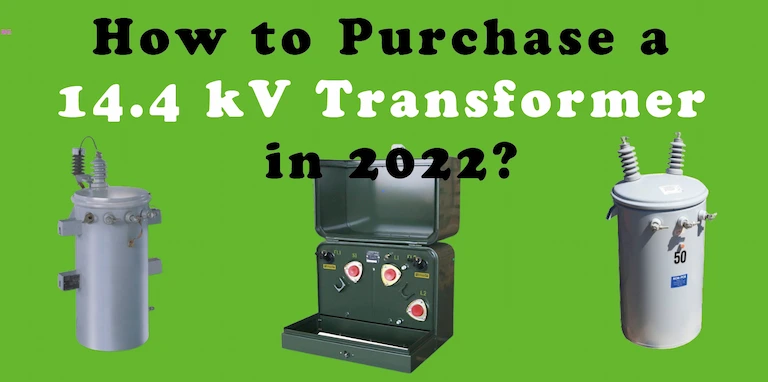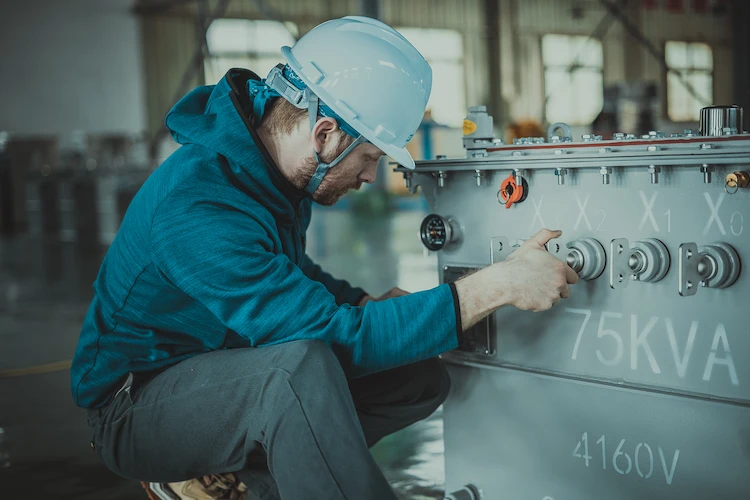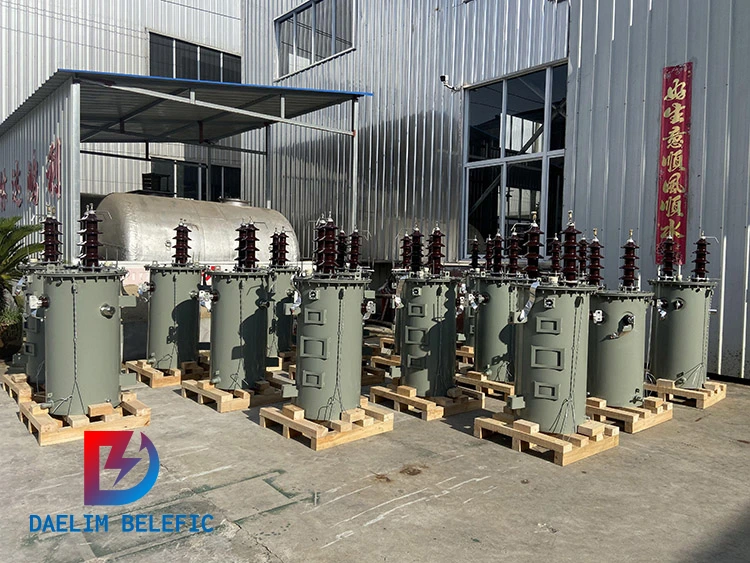
How to Choose Pad Mounted Transformer?
Table of Contents Selecting the right pad-mounted transformer requires careful consideration of several critical
ELECTRIC, WITH AN EDGE

With transformers consistently evolving, only a few manufacturers are prioritizing quality over quantity, and in the case of 14.4 kV transformers, this type of transformer is known to be produced in many numbers which is why quality control is a must for this level of transformer kV. 12.47 kV to 480v transformers and 34.5 kV to 480v transformers have also been noted for quality control as well due to massive production.
But before going through the complexity of 14.4 kV transformers, it is highly recommended to review first the basics of this transformer kV to not get confused as you go deeper into the article. DAELIM, a professional 14.4 kV transformer from China, will help you understand this by providing you with all the necessary information for this transformer kV.
For some consumers, people often think of transformer ratings differently and with a lot of variants in the market, it can be confusing which is why it is important to clearly understand transformer ratings first before going through the characteristics of 14.4 kV transformer.

For starters, you must have noticed that transformers and other powerful electric devices use kVA or kilovolt-amperes instead of kW or kilowatts. So, why aren’t transformers rated in watts? To understand this concept keep in mind that voltage ampere (VA) is equal to the Voltage multiplied by Amperage.
On the other hand, kilovolt-ampere is equal to the same formula which is Voltage multiplied by Amperage but it is divided by 1000 afterwards.
Now that you know the formula for VA and kVA, what about formulas related to watts? For watts, Voltage Amperage will be multiplied by the Power Factor. For kilowatts or kW, there are three elements to be multiplied and that is Voltage multiplied by Amperage multiplied by Power Factor then divided into 1000.
As you can see from the formulas above, the formulas of voltage ampere and watts are very similar. The slight difference between them is the presence of the Power Factor in the Watts formula.
In the case that the Power Factor is equivalent to 1, it is expected that the Voltage Ampere will be equal to watts. However, if the Power Factor results in 1, then there will be no utility for watts since the Voltage Ampere can also be equal to 1.
With all these data, you can conclude that the Power Factor is not the numeral 1.
The Power Factor will heavily depend on the load that is connected to the 14.4 kV transformer or generator present. Loads can actually vary like resistive, inductive, capacitive, and can be a hybrid. Transformer manufacturers will not be certain of what of you will use, it will not be possible for them to exactly know the Power Factor.
Simply take it like this, if the manufacturers know how much load there is, they will also know the Power Factor. In the case that they do not know the load, then they will not have an idea how much there is for Power Factor and Kilowatts.
For this specific reason, this is why transformers, generators, and other powerful electrical devices use kVA, not watts.

Now that you know why transformers and other powerful electrical devices use kVA instead of kW, it is time to move on to why motors use kW instead of kVA? For starters, motors and transformers are very different which means they do not belong in the category when it comes to power.
In addition to that, transformers and motors have different utilities. In terms of its formula, it is rated in watts which means you will the Watts is equal to Voltage Ampere multiplied by the Power Factor.
This goes to show that the Power Factor is known, unlike transformers. This is why you can easily add this to your voltage equation for you to solve the total Watts. This is the primary reason why motors are rated in Watts and not in kilovolt-amperes.
For many, seeing 34.5 kV to 480v transformer or 12.47 kV to 480v transformer can be intimidating and confusing. The easiest way to determine a transformer’s rating is through its size. The bigger it is, the higher their rating is, and the smaller it is, the lower the rating is its rating as well.
In general measuring, that is how you do it, but what about accurately telling a transformer’s rating? You can do so by learning the abbreviations of the units being used first, which you already know (kV, kVA, VA. etc.).
Usually, small transformers are rated in Voltage Amperes. A transformer that has a rating of 100 Voltage-amperes is capable of withstanding 100 volts that is at one ampere of current. 1000 volt-amperes is basically equivalent to 1 kVA which is the reason why small transformers use the unit of voltage-amperes only.
So how do you determine a transformer’s kVA size? For starters, you will have to create multiple calculations that is based on the principle of electrical schematics which can be confusing if you do not know the basics.
Nonetheless, the electrical load that is associated with the transformer’s secondary winding will need a certain input or voltage load. Mark that as your voltage “V”. Afterwards, you will then need to know its voltage.
Take 150 volts as an example.To know what is the current flow of the electrical load, you will need to review the electrical schematic to help you know what number is needed to proceed. If ever you will not be able to find the current flow, you can try to calculate it through division.
Dividing the input’s voltage by the resistance of the input will give the chance to determine how much load is required in kilowatts. Another equation is required for this and the formula to be used is to multiply the needed voltage or “V” by the current load that is needed that will be in amperes. Lastly, you will have to divide the number by 1000.
For many, seeing 34.5 kV to 480v transformer or 12.47 kV to 480v transformer can be intimidating and confusing. The easiest way to determine a transformer’s rating is through its size. The bigger it is, the higher their rating is, and the smaller it is, the lower the rating is its rating as well.
In general measuring, that is how you do it, but what about accurately telling a transformer’s rating? You can do so by learning the abbreviations of the units being used first, which you already know (kV, kVA, VA. etc.).
Usually, small transformers are rated in Voltage Amperes. A transformer that has a rating of 100 Voltage-amperes is capable of withstanding 100 volts that is at one ampere of current. 1000 volt-amperes is basically equivalent to 1 kVA which is the reason why small transformers use the unit of voltage-amperes only.
So how do you determine a transformer’s kVA size? For starters, you will have to create multiple calculations that is based on the principle of electrical schematics which can be confusing if you do not know the basics.
Nonetheless, the electrical load that is associated with the transformer’s secondary winding will need a certain input or voltage load. Mark that as your voltage “V”. Afterwards, you will then need to know its voltage.
Take 150 volts as an example.To know what is the current flow of the electrical load, you will need to review the electrical schematic to help you know what number is needed to proceed. If ever you will not be able to find the current flow, you can try to calculate it through division.
Dividing the input’s voltage by the resistance of the input will give the chance to determine how much load is required in kilowatts. Another equation is required for this and the formula to be used is to multiply the needed voltage or “V” by the current load that is needed that will be in amperes. Lastly, you will have to divide the number by 1000.
As mentioned, with the example 150, you will multiply that number by 50 in order to get a result of 7,500. Now that you have 7,500, divide that by 1000 to achieve the result of 7.5 kilowatts. The final step would be to convert its unit from kW to kVA.
When doing this, make sure that you will divide by 0.8, because this number represents the Power Factor that is in a load. So after dividing 7.5 by 0.8, you will get a result of 9.375 and this will be in kVA.
When you are looking for a transformer, it is most likely that you will not find a transformer that is rated 9.375 kVA or below because transformers that are in a kVA rating are normally rounded off to whole numbers which means that there will be no 8.355 kVA, 7.200 kVA, and so on in the market.
Usually, you will find transformers such as 30 kVA, 40, kVA, 50 kVA, and so on in the market. Depending on what your project or purpose of purchasing a transformer is, it is recommended that you choose a transformer that a higher rating than the result of your formula.
You also have the option to work the opposite way by using the most well-known kVA transformers to calculate the amperage that you want to utilize. For instance, if your transformer of interest is rated around 1,5 kVA and you want to amp it up to be used around 20 volts, you will have to multiply somewhere around 1.0 by 1000 to get 1200-1300 then divide it by 1500 to get the result of 40-60.
This will allow you to operate your transformer around that level of amperes of current.
Medium-voltage transformers like 14.4 kV transformers are basically used for multiple industries and businesses including but are not limited to hospitals, schools, and other large establishments. Medium-voltage transformers help ensure its consumers run operations smoothly with little to no power interruptions.
However, this can be considered a problem if the transformer is poorly manufactured, which is why DAELIM strongly recommends that you purchase a medium-voltage transformer from trusted transformer manufacturers with an excellent reputation to guarantee your safety.
In recent times, there have been a lot of reports concerning transformers catching themselves on fire and even exploding mainly because of poor quality and improper cabling management. This is the reason that once you purchase a transformer, make sure you have a professional team with you.
DAELIM offers abroad services to help you install their transformers worldwide so that you will not go through a lot of hassle installing. Moreover, you will be taught how to properly operate the transformer and how to maintain it.

If you are a crypto investor and you want to invest in a transformer for your mining farm 14.4 kV transformers can definitely get the job done. However, since it is a medium-voltage transformer, you must be cautious of its load because it can easily overload if you are using too many mining rigs.
14.4 kV transformers are recommended for small to medium crypto mining farms. If you have this project, then 14.4 kV transformers are perfect for your needs. But for crypto mining farms that are big, it is best that you go for higher-rated transformers to efficiently mine without power interruption or losses.
Keep in mind that your cryptocurrency farm must have an excellent exhaust for airflow because a cryptocurrency mining farm with bad airflow can easily go up in flames due to the high temperatures of the mining rigs.
This is one of the many reasons why you should get an efficient transformer from a reliable and trusted manufacturer because crypto farms are prone to fire. You should also consider that if you are planning to do a cryptocurrency mining farm, you must have professional electricians check your plan first before even starting.
This way, you will be able to tell if your crypto farm is safe or not to be operating. DAELIM will be able to assist you with this if you have questions on what type of transformer you should use and what are other electrical devices needed for your project to operate smoothly.
DAELIM’s 14.4 kV transformers have been expertly crafted by professionals that is designed to be compatible with agricultural electric networks, villages, subdivisions, and many more. Its structure is of a single-phase pillar type transformer that comes with multiple parameters to give you the most accurate readings.
It runs on a single-phase system with two windings and a frequency of 50-60 Hz. DAELIM’s 14.4 kV transformers are oil-type which means its cooling system requires transformer oil or mineral oil to regulate its temperature. Oil cooling is known to be the most efficient way to cool transformers compared to forced or pressurized air.
When it comes to its coil structure, it is toroidal and its components are mostly made out of high-quality copper. Its supply ability is rated around 800 set or sets per month. For its package and delivery, this will depend on the client’s request.
It can come in a secure wood packaging that can be shipped via air or water transportation to your location.
Although 14.4 kV transformers have a significant difference in terms of performance compared to higher-rated transformers, there is without a doubt that they will get the job done smoothly, just make sure that you are not overloading it because this can easily cause the transformer to malfunction.
Moreover, when it comes to maintenance, they may not require frequent maintenance but this does not mean you should not do a regular check-up on it every few months or so. 14.4 kV transformers can last for more than a decade if properly taken of, which is why you should do your part in maintaining it to extend its longevity.
If you have questions or clarifications, do not hesitate to contact DAELIM, and they will offer you professional help right away.
Download Resource

Table of Contents Selecting the right pad-mounted transformer requires careful consideration of several critical

The primary function of the pad mounted transformer is to serve as a critical distribution

A pad mounted transformer operates through electromagnetic induction, serving as a crucial distribution component that
After filling in the contact information, you can download the PDF.